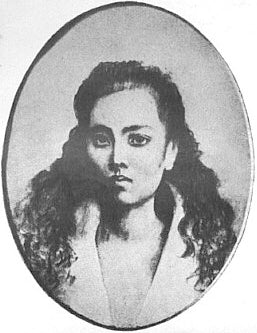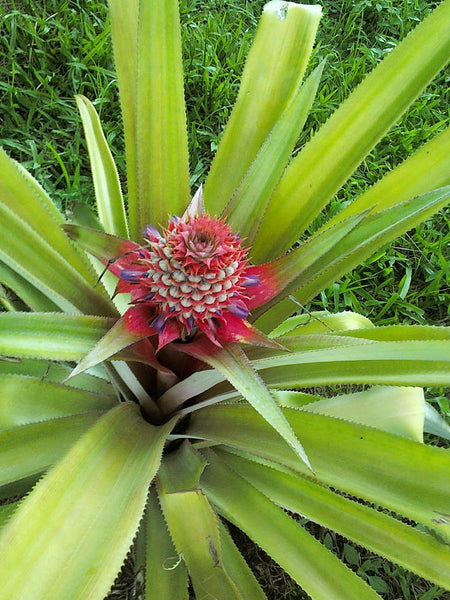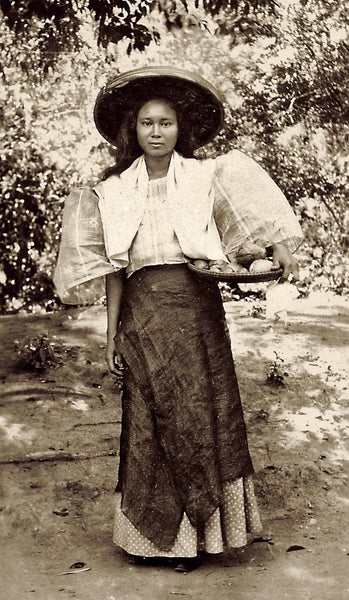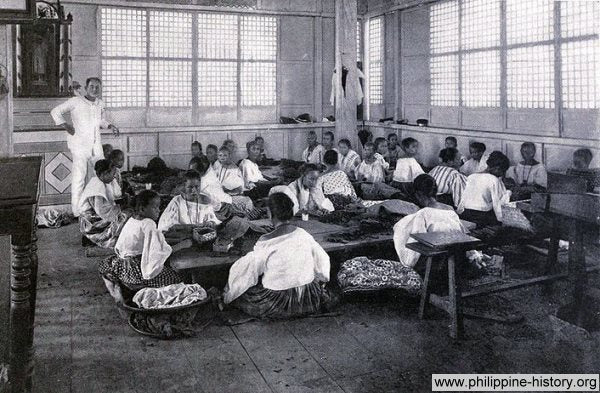In the Philippines, every high school student has to read two novels by our national hero, Jose Rizal: Noli Me Tángere and El filibusterismo. One of Rizal’s most famous characters is María Clara, the mestiza heroine and love interest of Juan Crisóstomo Ibarra y Magsalin, Noli Me Tángere's protagonist.
Ask a Filipina about María Clara, and they’ll tell you about being compared to her as a traditional, feminine ideal. Carmen Guerrero Nakpil, a prolific Filipina writer of the early 20th century, even describes María Clara as the “greatest misfortune that has befallen the Filipina in the last one hundred years.”
As a young girl, it seemed second-nature to me to be reserved and courteous. We were taught to fear the world, not show too much of ourselves, and strive to be beautiful like the women we watched on our telenovelas late at night. When I got older, I was reminded to be private about my personal affairs, not to reveal my intentions candidly, and appear mysterious because appearing too loud or forthright made me less of a lady. Underlying every Filipino parent’s neuroses is the fear that someone could hurt their little girl.
I was thirteen, an anxious adolescent both angry and falling in love with the world, when I learned that these cultural beliefs were a product of Western sexist ideology—and epitomized by María Clara herself.

A crayon sketch of Leonor Rivera, the basis of the "María Clara" character in José Rizal's Noli Me Tángere. Today many know her name through the María Clara dress. (Source: Wikimedia)
Who is María Clara?
In the novels, María Clara is described as a devout Roman Catholic who became the epitome of virtue, "demure and self-effacing,” humorless and prone to fainting. Her traits were further described by Rizal as an "Oriental decoration" with "downcast" eyes and a "pure soul". She was bullied by her parents and abused by friars. At the end of the novel, she winds up in a nunnery, only to be further abused there.
Until now, critics haven’t been able to agree whether her character was a satirical social comment or if Rizal simply had a preference for a certain type of woman.
In a paper written by Jean-Noël Sanchez, he mentions that Rizal had an explicit agenda for Filipino women. This was expressed in his famous piece, Letter to the Women of Malolos (1889).
Sanchez writes, “In this text, which he sent to his sister, he granted them the mission to educate the future Filipino citizen in the love of his motherland. Women were then supposed to maintain themselves in their suffering role of loving mothers, sisters and wives of the male heroes entitled with the virile mission of nation-building. They were supposed to be inspirers, caring providers, not instigators and even less actors.”
Because of Rizal’s novels and their popularity, María Clara became a cult figure. Her image reinforced the suppressive and sexist views of what it meant to be a Filipina in the 20th century. Leaving most women in the wake of the Spanish colonization to adhere to false beliefs about themselves—a prophecy that determined future grievances.
Nakpil particularly lays the blame on the generation of readers after the publication of the novels: “Instead of giving their attention to her strength, her nobility, her inherent stubbornness, they made a cult of her capacity for fainting and blushing.”
The Filipina Poets Who Wrestled With The María Clara Ideal
The subtle defiance of women in the 20th century is most evident in the poetry. A generation of poets began to ask questions about sexuality and bodily autonomy. They struggled to come to terms with their collective identity as a citizen, woman, and self.
Below are some poems that demonstrate the growing defiance of the younger generation towards the María Clara ideal:
Today I climbed about the hill on just the hopeful chance
To learn the crimson promises of many piña plants
They live like sturdy splinters in still grey green restraint
One could not call them wispy and one could not call them quaint
They neighbor in their own sharp way with all the verdure
of the hill;
And never envy other plants their opulence of chlorophyll
It’s my delight to see, deep in the gorgeous, secret part,
Each holds a blazing carmine love within her cloistered heart.
- Juana Wilson, Pineapples in Bloom (1938)

In "Pineapples in Bloom", we see a woman’s foray into self-exploration. She uses the piña plant as an analogy for selfhood, which she describes as neither “whispy” or “quaint.” Her choice of words already refers to a transcendence of the María Clara image.
The most compelling part is the existence of a “gorgeous, secret part” holding a love described as “blazing” and “carmine”. The last two verses are full of implications of passion and consciousness withheld. But the narrator is delighted by what she sees at the heart of the plant. According to a paper written by Edna Zapanta-Manlapaz and Ruth Cudala, Wilson “subtly enjoins other women to bolt out of their presumably male-designed cloisters to make similar journeys into their ‘gorgeous, secret parts’ and discover within themselves the sexual dimension which confirms that they are, after all, gloriously alive.”
Another poem with a similar undertaking is that of Toribia Mano’s "Tambourines in My Heart". Here she protests more aggressively, contesting the “lifelessness” of which they have associated her:
You should not be sitting there looking at me
As if I were the shadow of your face
Or the light suddenly gone out of a star
Or a pale white meadow
There are many things to think about:
You should not be sitting there and looking at me
As if I could not stir.
You should not be sitting there and looking at me.
You should be holding me and kissing my mouth.
- Toribia Mano, “Tambourines in my heart” (1947)
She likens man’s idea of her as three things: the shadow of his face, the light suddenly gone out of a star, and a pale white meadow. All of which suggests something diminutive, dull, and ephemeral. Then she demands that she be thought of as “many things”, a living, breathing entity. In the end, the narrator makes a demand but is still at the mercy of a man’s prerogative to act.
Filipina Women in the 19th Century and Now
By the end of the 19th century, the Philippines was exporting sugar, abaca (Manila hemp) and tobacco, which paved the way for the Philippine economy’s growth. Urbanization changed the way Filipinos lived and how they related to their neighbors.
There came an emergence of a class of Filipinos possessing conspicuous wealth. These women were largely relieved from physical labor but often had responsibilities in the home, entertaining European guests or maintaining the appearance of culture.
Although this new elite class of Filipinas were the most documented, censuses and registers show there were far more working class women in Manila.
In a study conducted by Ma. Luisa Camagay, we discover that they did actually work as cigar-makers (cigarreras), domestic servants (criadas), store owners and vendors (vendaderas or tenderas), seamstresses and embroiderers (bordadoras and costareras), school teachers (maestras), midwives (matronas titulares) and prostitutes (mujeres publicas).

A Filipina again looking elegant while working in traditional Maria Clara gown
(Source: Philippines Lifestyle News)
There’s also evidence of Filipinas asserting their place economically through petitions for better wages or working conditions, complaints, and even strikes. They engaged in nondomestic work depending on their regional economy, such as in tobacco cultivation. We find staggering evidence of this from a multitude of historical Filipina figures that paved the way for revolution and innovation throughout history.

Manila Cigar Factory, 1899. (Source: Philippine History)

Embroiderers in Old Manila with American troops in 1899
(Source: Morrighan’s Muse)
Highlighting Our Stories
Throughout history, María Clara may have been forced onto Filipinas as an ideal of womanhood. But Filipinas have been anything but passive.
We continue to confront the forces of colonialism and capitalism; breaking free of "male-designed cloisters" created to contain us.
Reflecting on my own experience, I’ve been able to write a different story for myself. My story puts me at a place of privilege because I have the luxury to express myself in ways the working women of the 19th century were never afforded.
I’m a 22-year old with tattoos. I see an OB-GYN for my reproductive health. And every time March rolls in, we celebrate one day to remind ourselves that our voices matter.
We can only wish then that fiction imitated more of life. As a global Filipina community, we need to write more stories that reflect our own reality and the challenges we face today. The place of Noli and El Fili in Philippine literature is undeniable but now, more than ever, is the time to rewrite our stories and shape what lies ahead.
*Cover photo via Biblioteca Nacional de España care of Fashionable Filipinas.
Want to read more from Pinays who are writing their stories and shaping the future?
Subscribe to our weekly newsletter for inspiring stories from the diaspora. Plus, updates on how you can support Filipina entrepreneurs and artisans in the Philippines (with 10% off your first purchase!)
Zea Asis

Zea is a nonprofit professional in her past life. She now works for a design platform with the goal to democratize design and grow their online communities. Outside of work, she goes boxing, is learning how to design clothes and constantly curating her closet to look like a cool grandma.



Leave a comment